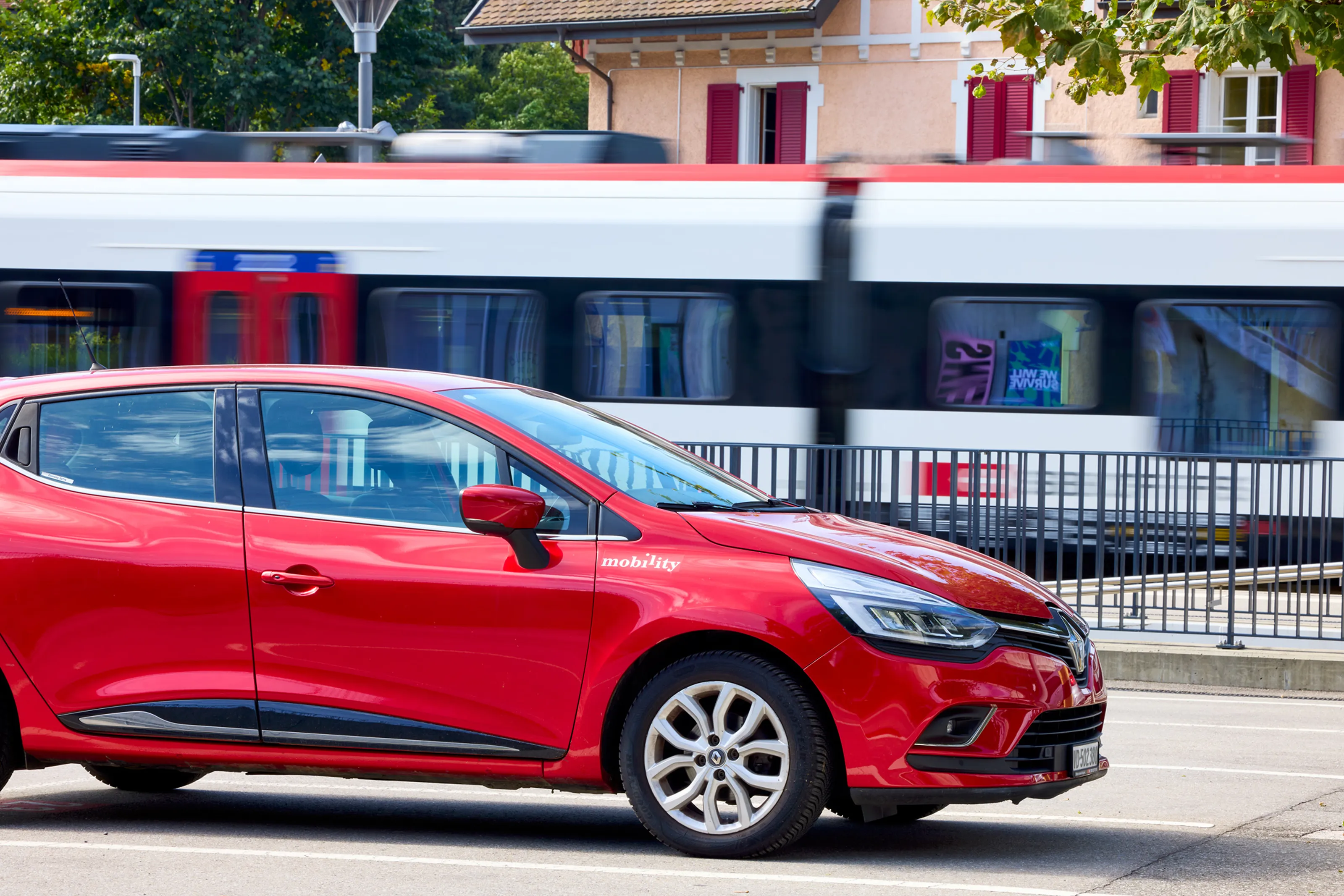Sustainable form of mobility
This is why car sharing is good for the environment
If you have to go by car, car sharing is the best solution for the environment. This has been shown by a new study by Mobility. The two main reasons are: One shared car replaces 18 privately owned cars. And those who use car sharing plan their routes more consciously.

The impact of car sharing on reducing traffic is well known. The Mobility Cooperative has commissioned an independent study to determine just how big of an impact it has in Switzerland. BSS Economic Consulting, in cooperation with the Eastern Switzerland University of Applied Sciences, surveyed 5’700 Mobility members about their vehicle ownership and mobility behaviour.
Key findings:
- One Mobility car replaces 18 private cars on average in Switzerland.
- Thanks to Mobility, there are around 40’000 fewer cars on the road.
- The impact differs at the local level. While it is even higher in cities (up to 23 in Basel), the number of cars replaced per Mobility car is still at 9 in rural areas.
- 73 per cent of respondents live in a household without a car.
- The degree of motorisation in households with a Mobility subscription is 2 times smaller in the cities surveyed than in average households.
- The Mobility offer plays an important role in the decision to get rid of your own car (over 50 per cent say «fairly big» to «very big»).
0%
Car sharing is changing mobility behaviour
People who use car sharing drive less than the average person, because each journey requires a conscious decision. Instead, shared car users are more likely to use public transport, e-bikes, bicycles or e-scooters – or to walk. The details:
- Car sharing is a part of multi-modal mobility: For each journey, you can choose the optimal means of transport and, if necessary, even switch seamlessly during the journey – car, train, bike etc. By contrast, if you own a car, you tend to use it frequently because the car is there.
- 15 per cent of Mobility members have used public transport more since signing up for car sharing. Furthermore, many members often walk or cycle.
- The results of the Mobility study are supported by further studies. For example, the number of kilometres travelled by car in car-sharing households was lower in Bremen, by half than in average households in terms of mobility. Some of the distances previously travelled by car were swapped for public transport by the car-sharing households. It has also been shown that the cooperation between car sharing and public transport strengthens the use of environmentally friendly means of transport. According to the German Car-Sharing Association (Bundesverband Carsharing), one third of German car-sharing users cycle more often, 40 per cent use buses and trains more often, and 70 per cent drive less. A study in France puts it this way: more shared kilometres always means fewer kilometres travelled individually.

Car sharing reduces greenhouse gas emissions from transport
Car sharing makes a large number of privately owed cars redundant. This has a positive effect on greenhouse gas emissions in the transport sector.
- One Mobility car replaces 18 privately owned ones. In rural areas of Switzerland, this figure is 9.5, while in cities it rises to 23. Fewer privately owed cars means fewer cars that have to be manufactured. This not only saves resources, but also reduces the greenhouse gas emissions caused by production.
- 15 per cent of Mobility members have got rid of one or more cars, half of them because of their Mobility subscription. Specifically, the number of vehicles in the households of Mobility members fell by 20 to 50 per cent compared to the twelve months prior to registering with Mobility.
- On average, car-sharing vehicles are more environmentally friendly than the average private car for two other reasons: Firstly, they tend to be newer than most privately owned cars. Car sharing means there are more efficient and thus more environmentally friendly cars on the roads. Secondly, at 20 per cent, the proportion of electric models in the Mobility fleet is much higher than the Swiss average for privately owned cars. And electric cars are known to be more sustainable than cars fuelled by petrol or diesel. With respect to the local environment, they even cause no emissions at all. It is therefore not surprising that car-sharing fleets have significantly lower CO₂ emissions than the average privately owned car registered in Europe.

Car sharing creates space and makes cities more liveable
Many cities are being choked by traffic these days. And the mass of parked cars prevents the transformation of areas into more liveable neighbourhoods. Car sharing, on the other hand, helps in many ways.
- Users of car sharing drive less. They use more means of transport that take the pressure off city traffic and infrastructure: e-bikes, bicycles, e-scooters, buses, trains – or they walk. This means that there are fewer cars on the roads.
- The study of Mobility members shows that large cities and conurbations, where the volume of motorised traffic is at its highest, benefit particularly from this change in user behaviour: One car-sharing vehicle replaces 23 vehicles in Basel and 21 in Geneva and Zurich.
- This means that car sharing contributes to lower local traffic emissions, meaning fewer particulates and fewer exhaust gases. Fewer cars on the road also means less traffic noise. This further improves people’s quality of life in the city.
Car sharing users drive less. They are travelling more by train, bus or bicycle.
- Since car sharing eliminates the need for many privately owned cars, the demand for parking spaces in cities is reduced.
- A reduced need for parking spaces means lower investment and maintenance costs for car parks.
- This contributes to the realisation of new residential concepts that are also being implemented in Switzerland: car-free or low-car construction. In these kinds of neighbourhoods, the usual requirements for the number of parking spaces to be planned per residential unit do not apply. Because many people who live in the city do not have a car anyway. Instead, they use bicycles, cargo bikes or car sharing. In these neighbourhoods, one tenth of the parking spaces per residential unit is usually sufficient. This creates more liveable space.